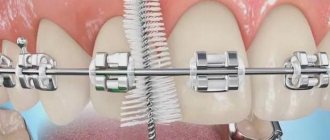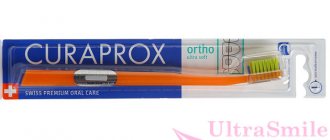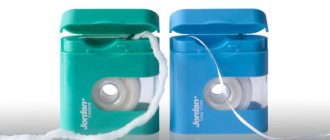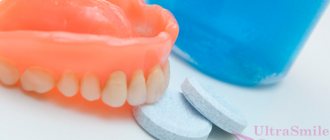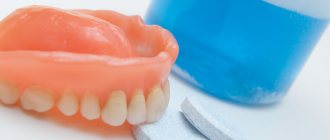From this article you will learn:
- how to use dental floss correctly,
- rating of the best floss models,
- dental floss – price in the pharmacy 2022.
Dental floss (floss) – designed to clean the interdental spaces from food debris. It is no secret that caries most often forms in the interdental spaces, which cannot be cleaned well with a regular toothbrush. And therefore, dental floss is an important element of oral hygiene, which helps protect teeth from caries and gingivitis.
Dental floss comes in small plastic containers. Depending on the manufacturer, the length of the thread in such a container can range from 20 to 50 meters. Each time before brushing, you will need to tear off a new piece of dental floss about 30-35 cm long. Thus, 1 package of floss will last you for a whole month, and its cost will be about 230 rubles per package.
What does the packaging of dental floss look like?
Unfortunately, most people do not floss regularly, believing that they only need to remove large pieces of stuck meat, and not stuck soft food debris. However, the latter are much more dangerous for teeth. Soft food residues consist predominantly of easily digestible carbohydrates, which are most easily converted by bacteria into acid, which destroys tooth enamel.
Moreover, the most aggressive damaging effect of bacteria on tooth enamel occurs during the first 30-40 minutes after eating (provided that you have not brushed your teeth). That is why it is recommended to use floss within the first 5 minutes, and so on after finishing each meal during the day.
Efficiency
Caries prevention is possible by brushing your teeth twice a day. The reproduction of bacteria is stopped, since they cannot live on a clean surface. However, the brush only copes with the internal and external areas. Meanwhile, food particles get stuck in the spaces between the teeth, where the bristles of the brush cannot penetrate.
As a result, pathogenic bacteria develop vigorous activity as food decomposes. The prerequisites for the formation of caries are created. The next stage is the appearance of carious cavities.
Use a thread to clean hard-to-reach areas. It is important to floss with a broken bite and with teeth located close to each other. It is partially possible to sanitize the cavities between the surface of the tooth and the gum - pockets. They are formed during periodontitis, and if you don’t take care of them, you can lose a tooth.
Kinds
Flosses differ in the processing method:
- waxed;
- not waxed.
In the first case, the thread is covered with a thin layer of wax. This facilitates easy sliding and unhindered removal of deposits.
The “tool” is made from:
- silks;
- nylon;
- nylon;
- acetate.
Natural silk is rare. It was originally used when floss first appeared. Today, mostly artificial options are presented on pharmacy shelves.
The threads are made according to the shape:
- flat;
- round;
- tape
Dr. Zubastik advises purchasing the first ones for people with tightly spaced teeth, the second and third ones for those with wide gaps.
The floss subtype with the prefix “super” is intended for those who wear braces. This design consists of several parts. But we'll talk about it a little later.
Non-waxed threads can be used by those who have experience in cleaning the interdental space with floss. It is believed that they cope better with this task.
Waxed ones are convenient for beginners. The thread does not get stuck anywhere, glides freely, and does not split. There is no risk that a piece of it will remain between the teeth.
To increase the effect, floss is impregnated with therapeutic and prophylactic drugs. This:
- sodium fluoride (prevention of caries);
- chlorhexidine (disinfection);
- menthol (breath freshens).
You should choose a floss only after consulting a doctor, because when choosing it on your own, you may not take into account the peculiarities of the condition of your teeth and gums, as a result of which, instead of benefiting your health, you will cause harm to your health.
How to choose dental floss –
There are a huge number of brands of dental floss, and as a dentist I have tried almost all of them. Unfortunately, very often you remain dissatisfied with the quality of dental floss, namely the fact that it may be too thin or thick, or it may become unfibered, tear and get stuck in the interdental spaces, or it may be uneconomical or simply poorly clean the interdental spaces. I will share my personal experience in this article, but I must say right away that the best dental floss does not exist, because... Different types of threads may be optimal for different patients.
Dental floss was invented in 1819 by a dentist from New Orleans (USA), who recommended his patients to clean the interdental spaces with waxed silk floss. The use of dental floss was not commercial at first, and it was not until 1898 that Johnson & Johnson received the first patent for dental floss made from silk. Around 1943, dental floss began to be made from nylon due to the greater strength of this material.
Modern dental floss is made from 2 materials: firstly, still from nylon, and less often, using polytetrafluoroethylene. An important point when choosing a floss is that the quality of dental floss made from the same nylon varies greatly. Unfortunately, the threads from most inexpensive nylon options begin to tear during the cleaning process and quickly become unfibered, as a result - a piece of thread can sometimes get stuck between the teeth (and will have to be removed with a new piece of thread).
Some manufacturers, in addition to the fact that dental floss is made of high-quality woven nylon, have a thin polymer film on top (for even greater strength), and waxed floss also has a thin layer of wax on top of the polymer film. It will be very difficult to break such a thread. This technology is used by Oral-B. However, the same company also has so-called monofilaments, which are made not from braided, but from a single solid fiber.
The second main difference is that threads can be produced waxed or unwaxed. Waxed dental floss is coated on the outside with a thin layer of wax, which makes it easier to glide between teeth and also gives the mouth a cleaner feel due to the fact that the wax may be impregnated with fluoride or menthol.
Waxed and unwaxed dental floss: which is better?
A study published by the Journal of Periodontology found that 79% of those surveyed preferred waxed floss. Moreover, patients were given a choice only after they had tried both types of thread. Unwaxed floss was preferred only by those patients who had crowded teeth and very narrow interdental spaces (this type of floss is somewhat thinner due to the absence of a wax layer).
If there are no Russian names on the packaging of the thread, then the package with waxed thread will additionally indicate “Waxed”, and the package with unwaxed thread will indicate “Unwaxed” (Fig. 4-5). Oral-b's packages of waxed and unwaxed threads look almost identical, so don't confuse them -
The advantage of waxed threads is that the wax can be additionally impregnated with fluorides, which makes it possible to further protect the interdental spaces from caries. In this case, the packaging of the dental floss will say “contains fluoride” (Fluorid). Typically, for these purposes, manufacturers use the fluoride compound “sodium fluoride” in a small concentration of 200 ppm. However, even this concentration of fluoride will further inhibit the growth of bacteria and protect tooth enamel from destruction.
Also, many patients noticed that waxed threads become less filamentous and tear during the cleaning process. This is also due to the fact that they are coated with a layer of wax, which further protects the interwoven nylon fibers. Unwaxed threads disintegrate much faster, and therefore many patients complained that they had to tear off the dental floss not once per brushing, but twice (thus increasing its consumption).
Important: Clinical studies conducted by the American Dental Association (ADA) have shown that there is no statistically significant difference between waxed and unwaxed floss in terms of interdental cleaning performance. And the choice between them lies solely in the sphere of your preferences. The most important thing here is that you do this procedure regularly after each meal, and not periodically on occasion (24stoma.ru).
It should be noted that waxed threads from different manufacturers have slightly different thicknesses. Therefore, if you have crowded teeth or very narrow spaces between teeth, then you are better off choosing either completely unwaxed or thin waxed floss. If you have poorly placed fillings in some interdental spaces that can loosen or tear the dental floss during the cleaning process, it is also better for you to choose waxed floss, because... this type of thread is stronger (and it’s even better to replace such fillings).
If you have wide interdental spaces, then thin threads will not suit you a priori. You need to buy thicker bulky threads, preferably waxed ones.
Use it correctly
There are 2 approaches to flossing teeth:
- Before carrying out the usual hygiene procedure using a brush and paste.
- After morning or evening cleansing is completed.
The first approach is closer to American dentists. They advise cleaning hard-to-reach areas before picking up a brush and starting the usual procedure. In Russia, doctors often recommend operations in the reverse order: brush your teeth, floss.
Regardless of what order you follow, the following rules are mandatory:
- Wash your hands.
- Cut a piece of floss 30-40 cm long.
- Take it so that part is wound around the middle finger of your right hand, and pinch part between the thumb, index and middle fingers of your left hand.
- Place the strip behind the tooth, trying to grab it, and move it up and down.
- Start with the upper jaw.
Remember : you cannot use one piece twice! If there is food or bacteria left on it, it can be transferred to the adjacent tooth. Inflammation will arise, and you will end up with what you were running away from: caries.
If there are no special recommendations from the dentist, then carry out the procedure once a day.
Indications for use
Flosses are used to clean hard-to-reach spaces and crowded teeth. Indications for use :
- periodontal diseases;
- the presence of non-removable orthopedic or orthodontic structures;
- approximal fillings;
- the presence of an implanted implant.
Doctors recommend using floss, since a toothbrush is not able to completely clean teeth of food debris. The product can be used for gingivitis that is not accompanied by gum recession.
What if I have braces?
Regular oral care with floss is required.
Braces can become a source of infection if they are not cared for properly. Complete cleaning with a brush is not possible. The smallest particles - food debris and harmful bacteria - are located in the places of fastening.
Step 1
Step 2
Step 3
Step 4
To avoid this, make it a rule to keep dental floss in the bathroom and regularly do “spring cleaning.”
You will need waxed floss - they will not touch the elements of the system. The second, more reliable way is to buy superflosses. The difference is this: superfloss is made of three materials. There are:
- hard fiber;
- sponge fiber;
- synthetic thread.
The principle of use is the same as for a regular one, only the result is achieved faster.
Finally, superfloss
Examples of superfloss: Miradent or Oral-B. With braces in place, if you're just starting to master the art of flossing, also try Sensodyne Floss or Lacalut.
What is superfloss?
Superfloss is dental floss that has different shapes in different areas. It is used to clean orthodontic structures, implants, bridges and braces .
Most superfloss is regular dental floss. This area is used to clean out gum pockets. The pointed tail is necessary for cleaning under the bracket arch.
The thickened part is made of sponge material. It is designed for cleaning braces with a lock. To avoid damaging the orthodontic structure, you should consult your doctor in advance.
Crowns are not an obstacle
Many people are wary of advice to use floss if part of the teeth are covered with crowns. This fear is unfounded: such teeth also require careful care. The material that is placed between the crown and living tissue dissolves over time. Bacteria and plaque accumulate in these places. It must be cleaned off, because otherwise inflammation of the adjacent soft tissues is possible. This is fraught with the development of periodontitis.
We brush in the same way as usual, without distinguishing between “live” teeth and those covered with a crown. It is especially important to observe this rule in relation to metal ceramics. It is convenient to use superfloss.
Recommendations for children
Dental floss is recommended for adults. In childhood, use is not always advisable. Dentists do not recommend using it under 12 years of age because:
- the mucous membrane is delicate and easy to injure;
- not all milk teeth were replaced by permanent ones;
- The child’s movements can be sudden, which sometimes causes bleeding gums and inflammation.
After reaching the age of 12, and with the approval of the dentist, a teenager can floss their teeth. The first session should be conducted under parental supervision.
Contraindications
Floss has its contraindications for use. Such a product should be discarded if there are carious lesions . In this case, dental floss can lead to chipping of hard tissues.
Other contraindications include the following dental diseases:
- pulpitis;
- periodontal disease;
- bleeding gums.
When using the product during such diseases, activation of the inflammatory process and the formation of wounds on the gums is possible .
Attention! Before using such a dental device, you should consult a doctor and carry out a complete sanitation of the oral cavity.
Toothbrush or floss
The natural question is: why do I need floss if I always brush my teeth twice a day with a modern brush, the manufacturer of which promises that it provides penetration into the “most difficult to reach places”?
Despite the improved shape of the brush, it is not able to achieve the degree of cleaning that the thread provides. The villi do not penetrate into the gaps between the teeth. This means that part of the plaque remains untouched.
At the same time, the brush is safer: if you carry out hygiene procedures 2–4 times a day, it is impossible to cause injury. Floss should not be used more than once a day.
Floss does not clean the front or back surfaces. Therefore, these hygiene items are not interchangeable. They complement each other.
Dental floss Sensodyne –
Sensodyne waxed dental floss has a fresh mint flavor and is additionally impregnated with sodium fluoride - at a concentration of 200 ppm. The peculiarity of this thread is that in the process of cleaning and wetting the thread with saliva, the thread becomes voluminous, which makes it possible to perfectly clean the interdental spaces. However, this floss may not be suitable for those who have very narrow interdental spaces.
This dental floss has the best reviews. It gives an excellent feeling of cleanliness, and we put it number one in our rating. During all the time of use, the thread has never broken (but the author of the article does not have overhanging edges of fillings in the interdental spaces, so how it will behave in the presence of them is unknown). On Sensodyne, dental floss - the price will average from 200 to 250 rubles, but in some online stores the cost can even start from 140 rubles.
The package contains 30 meters of thread. By the way, Sensodyne dental floss (as well as Elmex floss) is an analogue of the famous Swiss dental floss, but only at a much more affordable price. It was the Curaprox company that invented the technology for making bulky dental floss, but the original Curaprox dental floss will cost you about 2,500 rubles.
special instructions
Like any therapeutic and prophylactic method, the process of flossing teeth has contraindications. Avoid this oral care method if you have:
- caries has been diagnosed and not yet healed (pieces of teeth affected by microbes break off);
- gums bleed;
- Many crowns, bridges and implants have been installed.
The last case is a relative contraindication. Doctors allow and even recommend dental floss, but only after a thorough examination of the oral cavity. Old crowns and bridges are replaced and approval is given for the purchase of floss.
Elmex dental floss –
Before we tried Elmex dental floss, Sensodyne dental floss was in 1st place in our rating, which you can see below. Elmex dental floss is a so-called “bulk floss”, i.e. it becomes more voluminous in the process of cleaning the interdental spaces and wetting with saliva. Due to this, the quality of cleaning the interdental spaces increases, but a limitation also appears - this thread is suitable for patients with normal and wide interdental spaces. If your teeth are very close to each other, it is better to opt for Oral-b dental floss, which we will also discuss below.
Dental floss Elmex (Elmex) –
Elmex waxed thread consists of 144 thin nylon fibers coated with a polymer sheath. The thread is very resistant to tearing, and can break or become loose only in one case - if you have sharp overhanging edges of fillings in the interdental spaces. The thread is impregnated with the most effective anti-caries agent - aminofluoride (synonym - olaflur), which provides additional protection against the occurrence of so-called interdental caries. The thread has a pleasant minty taste.
In principle, Elmex dental floss in its properties, thickness, and manufacturing technology is almost completely similar to Sensodyne dental floss (see below). However, it is more economical, because the package contains 50 meters of thread, and not 30 meters - like Sensodyne. The price for Elmex thread starts from 220 rubles, in general it is a very worthy thread, which we recommend (and here I would like to make a small remark - if you already have the skill of using dental floss; if not, then it is better to start with thinner Oral-bi threads ).
Advice from Dr. Zubastik
Strips or threads are a universal remedy for maintaining healthy teeth and gums. Therefore, use them along with a brush. But follow your dentist's recommendations. So, let me remind you:
- Brush your teeth carefully! Excessive force can cause wounds and microtrauma to the gums.
- If you do touch the gum and see blood, stop the procedure and rinse your mouth with warm, salty water. Do not floss until the tissue is completely healed.
- Once a day is enough. Don't go overboard with your desire for cleanliness.
- Get your children used to flossing and tell them in advance about the benefits of the hygiene product.
- If there are contraindications, visit your dentist for advice. You may be allowed to buy floss after treatment.
Useful video:
Don't forget the main thing: oral care should be regular! Only then will it guarantee the absence of pathologies. Take care of your teeth and gums, and they will remain healthy until old age.
Tags: dental floss, floss, teeth cleaning
About the author: Dr. Zubastik
Typically, a toothache begins to subside on the way to the clinic and finally goes away after 10 minutes of sitting in line to see the dentist.
- Related Posts
- Can tartar fall off on its own?
- How to use dental floss correctly?
- How to use an oral irrigator?
« Previous entry
Oral-B dental floss –
There are several models of Oral Bee dental floss, each of which has its own advantages. For example, one model of thread is more suitable for thin interdental spaces, another does not break even in the presence of overhanging sharp edges of fillings in the interdental spaces, the third is universal. However, we placed Oral Bi dental floss only in second place in the ranking.
- Dental floss Oral-B Essential Floss (Fig. 9-10) - consists of nylon fibers coated on the outside with a polymer film, which gives the floss additional strength and does not allow it to easily fray when cleaning. This thread option can be waxed or unwaxed. The packaging with waxed thread will additionally indicate in English - “Waxed” (on the packaging of Polish production “Woskowana”), and on the package with unwaxed thread - “Unwaxed”.
Keep in mind that the waxed version of Oral-B Essential Floss will be slightly thicker, while the unwaxed floss will be thinner and have a less menthol flavor. This is an excellent option for dental floss in terms of quality and price; they do not tear or become loose. Their cost will be only about 230 rubles (50 m in a package), which makes this option for dental floss the most attractive in price.
- Dental floss Oral-B PRO-EXPERT Clinic Line (Fig. 11-12) – this version of dental floss has the highest strength. This is due to the fact that this thread is made in the form of a monofilament (while most other threads are multifilament, i.e. they have a large number of nylon threads intertwined with each other). This makes this dental floss very convenient for patients in whom other floss often breaks and becomes loose in the interdental spaces.
The thread is made in the form of a wide thin ribbon, impregnated with a strong menthol aroma, and there is no layer of wax on it. The cost will be from 250 rubles, but the package will contain 25 m (which makes it 2 times more expensive than most other dental floss). - Dental floss Oral-B Satin Floss (Fig. 13-14) - this version of dental floss is also made in the form of a tape, very thin, but wide. This floss is most suitable for patients with crowded teeth and very narrow interdental spaces. The fiber of the floss is very smooth and it glides easily between the teeth. The thread is unwaxed, i.e. it is not covered with a layer of wax. Has a pleasant menthol aroma.
We recommend its use only in patients with very narrow interdental spaces. In other cases, it is better to choose other types of threads (listed above). The cost will be from 210 rubles (the package contains only 25 m, which again makes it not the cheapest).
But, as you will understand below: the most difficult thing is not choosing dental floss, but how to use dental floss correctly. This skill is quite complex, but with regular use you will be able to use it quite well within a few weeks.
→ Rating of the 2021 best toothpastes → Advantages of dental fluoridation
